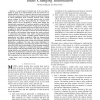Free Online Productivity Tools
i2Speak
i2Symbol
i2OCR
iTex2Img
iWeb2Print
iWeb2Shot
i2Type
iPdf2Split
iPdf2Merge
i2Bopomofo
i2Arabic
i2Style
i2Image
i2PDF
iLatex2Rtf
Sci2ools
AROBOTS
2007
2007
Structure-based color learning on a mobile robot under changing illumination
— A central goal of robotics and AI is to be able to deploy an agent to act autonomously in the real world over an extended period of time. To operate in the real world, autonomous robots rely on sensory information. Despite the potential richness of visual information from on-board cameras, many mobile robots continue to rely on non-visual sensors such as tactile sensors, sonar, and laser. This preference for relatively lowfidelity sensors can be attributed to, among other things, the characteristic requirement of real-time operation under limited computational resources. Illumination changes pose another big challenge. For true extended autonomy, an agent must be able to recognize for itself when to abandon its current model in favor of learning a new one; and how to learn in its current situation. We describe a self-contained vision system that works on-board a vision-based autonomous robot under varying illumination conditions. First, we present a baseline system capable of colo...
| Added | 08 Dec 2010 |
| Updated | 08 Dec 2010 |
| Type | Journal |
| Year | 2007 |
| Where | AROBOTS |
| Authors | Mohan Sridharan, Peter Stone |
Comments (0)

